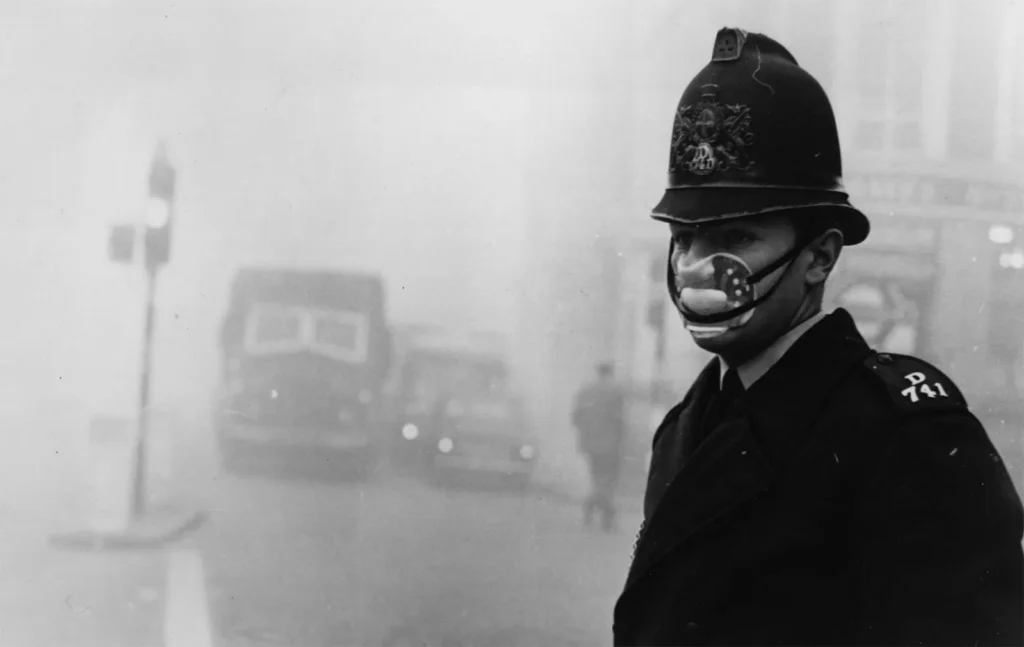Deep into the winter of 1952, London, England, fell victim to a strange and devastating environmental event the city had never seen before.
At the time, laws controlling the output of pollution and the understanding of airborne pollutants were minimal, but once the Great Smog fell over the city in 1952, everything would change.
For five relentless days, London would be covered in a toxic haze, borne from its reliance on coal as a power source. The fog was so thick that transportation ground to a halt, and the hospitals filled with patients struggling to breathe.

The Great Smog of London 1952
The morning of December 5, 1952, was bright and clear, giving no indication of the immense amount of smog that was coming.
It was also colder than usual, even for the winter months, which led to Londoners eagerly lighting their fireplaces to drive away the heat. Soon enough, the cold would be nearly forgotten in the face of the all-consuming smog.
What Caused the Great Smog of London in 1952?
Smoke poured from residential chimneys, but they weren’t the only ones contributing to the darkening skies.
London was rife with factories that pumped enormous amounts of pollution into the air, and the newly abundant automobiles weren’t helping, either.
London is, and was, a foggy city by nature, and no one gave it a second thought when a normal amount of fog appeared. What caused issues on that specific day was the presence of an anticyclone.
This caused a layer of warm air to form high, trapping a layer of very cold air below it.
This cold air was stagnant, with little or no wind to dissipate the smog as it formed, trapping all the pollutants within the cold air layer close to the ground.
A weather inversion like this would always create fog, but when combined with the large amount of soot and other pollutants being produced in London that were caught in the fog, it made something much more dangerous.
The fog began to turn a yellow-black color, something not totally uncommon for the area. These discolored fogs would be called pea-soupers, but this pea-souper was different. The fog was now undeniably smog.
At first, Londoners ignored the smog and continued about their daily lives with the expectation that it would disappear. The smell of sulfur filled the air from all the burning coal, and a black buildup slowly settled over the roads and sidewalks.
Transportation During the Great Smog
As visibility plummeted, transportation in London was quickly crippled. The underground train system was the only reliable system still running; everything aboveground was useless.
At its worst, the smog was so thick that people had trouble seeing their hands in front of their faces.
There was an effort to guide the huge double-decker buses through the streets with flashlights as guide beacons, but even this was quickly abandoned.
The soot in the air was so intense that those walking home from work would arrive with their faces blackened like that of a coal miner.
Cars were abandoned on the side of the road as drivers gave up attempts to drive in the horrible smog, congesting the streets even more.
Health Effects of the Great Smog of 1952
Unsurprisingly, the Great Smog had severe health effects for those who were forced to breathe it in for multiple days.
Since the smog was composed of pollutants, including sulfur dioxide and particulates, it swiftly caused a surge of respiratory issues among the population.
Bronchitis and pneumonia were common, and those who suffered from asthma were especially affected.
The main cause of death was hypoxia, or the body’s inability to get an adequate amount of oxygen, caused by the particulates in the air obstructing airways.
These health effects lasted a long time after the Great Smog, some not appearing until months later.
Overall, it was estimated at the time that 4,000 to 6,000 people perished because of the Great Smog. Modern estimates have increased that number significantly, and new estimates have put the number of deaths between 10,000 and 12,000.
Aftermath: The Clean Air Act of 1956
The Great Smog of 1952 finally lifted on December 9. Major criticism was leveled at the British government concerning how slow they were to address the Great Smog. It took years, but in 1956, a piece of legislation inspired by the Great Smog was passed.
The Clean Air Act of 1956 encouraged people to use less pollutive methods of heating their homes, such as gas fires. It also designated smoke-free zones and restricted the amount of coal burned within urban areas.
How Did Churchill Deal With the Smog?
In the media, the prime minister at the time, Winston Churchill, was often accused of being directly responsible for a number of the Great Smog deaths because he dismissed the threat of the smog..
While some sources claim that he encouraged Londoners to keep burning coal during the Smog, the Hillside College Churchill Project could not find a single instance of Churchill referencing the Smog during the event.
The popular television show The Crown depicts Winston Churchill visiting the hospital when his secretary is struck by a bus and killed because of the thick smog. This storyline is embellishment only and false. There was no secretary struck and killed, and Churchill never went to the hospital to see the Smog victims firsthand.

